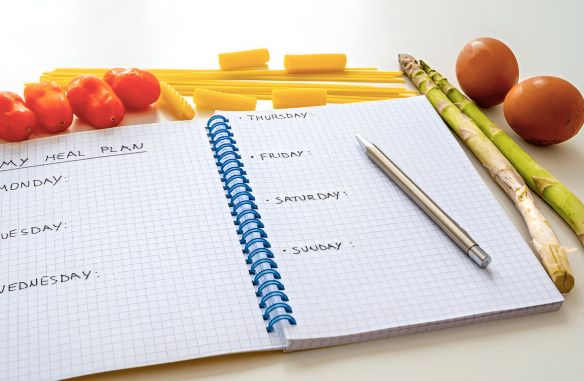Meal planning used to feel overwhelming. I’d scroll endlessly through recipes, buy too much at the grocery store, and still end up staring into my fridge every evening asking, “What’s for dinner?”
If you love traveling or learning about different cultures, reading about the best places to visit in Canada during summer can inspire fresh ideas, not just for trips but also for meals. Exploring food is a great way to connect with a place, and Canada’s culinary scene reflects its diversity. For instance, you might enjoy checking out traditional dishes that define Canada’s cultural mosaic, which highlight the rich variety of flavors that influence Canadian cooking.
After a lot of trial and error, I finally found a simple, flexible way to plan my meals each week—without the stress. If you’re looking to eat better, save money, and avoid mealtime chaos, here’s exactly how I do it.
Step 1: I Keep It Realistic
The first thing I learned? Don’t try to be a gourmet chef every night. I used to plan elaborate meals for the entire week, only to burn out by Wednesday. Now, I keep it simple:
- 2 easy weeknight dinners
- 2 slightly more involved meals I actually enjoy cooking
- 1 “whatever’s in the fridge” night
- 1 takeout or leftovers night
- 1 flex day (in case something unexpected comes up)
This structure gives me variety without pressure. It also allows room for life to happen.
Step 2: I Start With What I Have
Before I look up new recipes or head to the grocery store, I check what’s already in my fridge, freezer, and pantry. Do I have chicken thighs I need to use? Half a head of cabbage? A bag of rice hiding in the back?
Planning around what I already own helps reduce waste and save money. Sometimes, I even challenge myself to make one full meal just from pantry staples.
Step 3: I Repeat What Works
We all have those go-to meals that are easy, quick, and always get eaten. In my house, that’s:
- Stir-fried veggies with tofu and rice
- Sheet pan chicken and root vegetables
- Spaghetti with garlic oil and greens
- Chili (I double the recipe and freeze the rest)
Instead of reinventing the wheel every week, I just rotate these tried-and-true meals and add one or two new recipes for variety.
Step 4: I Use a Meal Planning Template
I used to scribble down meals on sticky notes or forget what I had planned altogether. Now, I use a super basic meal planning template (just a printed grid with days of the week and meal slots) to organize everything.
Each week, I fill it out like this:
- Monday: Stir-fry
- Tuesday: Pasta night
- Wednesday: Leftovers
- Thursday: Sheet pan dinner
- Friday: Takeout
- Saturday: Family dinner (something fun)
- Sunday: Prep for the week + one-pot meal
Bonus tip: I stick the plan on the fridge so everyone in the house knows what’s coming.
Step 5: I Grocery Shop With a Purpose
Once I have my meals mapped out, I write a grocery list organized by sections (produce, dairy, protein, pantry). This saves me time and helps me avoid impulse buys.
I also shop once a week instead of multiple quick trips. It’s amazing how much that cuts down on food waste and spending.
Step 6: I Prep Just Enough
I’m not one of those people who preps seven days of meals in perfectly portioned containers. But I do spend an hour or two on Sundays doing light prep that makes my week easier:
- Wash and chop veggies
- Cook a big batch of rice or quinoa
- Make a sauce or dressing
- Marinate meat or tofu
- Bake muffins or energy bites for snacks
It’s just enough to take the edge off busy weeknights—without turning Sunday into a full-time cooking shift.
Step 7: I Leave Room for Flexibility
One of the biggest reasons people give up on meal planning? It feels too rigid. That’s why I never plan more than 5 dinners per week. Life happens.
Maybe I go out with friends unexpectedly or just don’t feel like cooking. By building in one “flex” day and one “leftover” night, I stay consistent without feeling restricted.
Why It Works for Me
This approach works because it’s not about perfection — it’s about creating a rhythm. I don’t spend hours on Pinterest or feel guilty if I eat toast for dinner. I just have a simple plan that helps me:
- Eat healthier
- Waste less food
- Save time and money
- Reduce weeknight decision fatigue
And most importantly — it’s sustainable.
Final Thoughts
Meal planning doesn’t have to be a burden. Once I stopped trying to do it all and focused on making it easy, it became a helpful tool instead of a chore.
Oddly enough, this process reminds me of how I plan my vacations — a bit of structure, but with room to be spontaneous. Just like planning a trip to the best places to visit in Canada during summer, the fun is in making things feel intentional but not rigid.
And while we’re talking about planning and flavor, I’m always inspired by how diverse foods shape our cultural experience. You can explore that side of Canadian identity in this beautifully written piece on traditional dishes that define Canada’s cultural mosaic It’s a reminder that food is more than fuel; it’s culture, memory, and connection.
So start small, be flexible, and give yourself permission to keep it simple. Your future self (and your fridge) will thank you.











